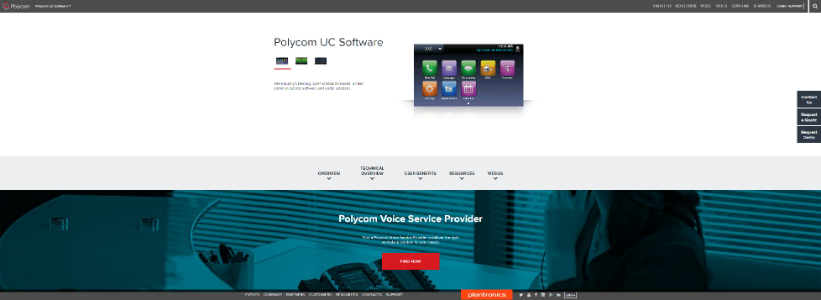Top 11 Unified Communications Software
What is Unified Communications? If you are looking into any part of the communications systems for your business you will run into this term quite a lot. I have read various articles on this field and honestly I believe there is no unified definition of unified communications. What I can tell you however is that the idea behind this is that the company or individual has a more streamlined experience when communicating with their staff. Just imagine being able to tell exactly where your agents are in the field so that you can allocate the right resource at the right time.
Read More: Top 10 Office Phone Systems For Small Business
This would be ideal for any service industry related business such as plumbing, electricians, or any business where the company’s employees may be better deployed by this unified communication.
One application to this is obviously GPS integrated cell phones. With these location aware cell phones it is very easy to determine the location of your staff in the field. This allows for faster response times and a better customer experience. I have even seen this lately with the snow plows up in Minnesota and Illinois. No longer do the residents of any major city need to wonder when their snowplow is going to come by and dig them out. Another application would be of course emergency personnel such as Fire and Police Officers. The potential to save lives with this technology is quite outstanding.
Read More: Top 10 Best Hosted PBX Phone Systems Providers for Small Business
Now of course unified communications and messaging solutions must cover the area of email as well. With the advent of email the speed of communication has drastically increased. Since you are dealing with a fully integrated phone and messaging system it would make sense that you could schedule meetings with your email servers and then simply teleconference in wherever you may be. This has made the office an antiquated paradigm. You could assemble a team of highly qualified people and then simply manage them through your communications system.
Again the next step in unified communications solutions has been the integration of the camera into the phone. With many phones now having the ability to talk face to face with each other you could talk to your staff face to face instead of an impersonal email or fax. While the written word can convey many thoughts there is no substitute for actually being able to see and communicate with someone in real time.
Read More: Top 11 Cloud Telecommunications Billing Software
The field of unified communications is ever evolving. With virtual tele-presence devices coming fast and furious the upcoming possibilities with unified messaging with IP communications are quite numerous and yet to be fully realized. The companies that take a hold of this new wave of communication and IP telephony, along with Voice Over IP, or VOIP, are those that are going to be best suited to assist their customers in the quickest and most efficient way. With these increases in unified communications benefits and efficiency comes in an increase in profit and customer satisfaction. Your company may live or die depending upon your choice of how you wish to fully integrate all of your communications systems together. The time to choose a reliable provider has never been so critical. So choose your unified communications equipment & services wisely.
Top 11 Unified Communications Software:
FUZE
Fuze is the Leader in Enterprise Global Voice, Video, Messaging, and Collaboration

FUZE
AVAYA
Avaya provides contact center & unified communications solutions for better customer experience, increased productivity, enhanced financial performance.

AVAYA
WILDIX
Wildix – multinational company operating in the field of Telecommunications: VoIP, Multimedia PBX, WebRTC and Unified Communications.

WILDIX
FIVE9
With Five9, businesses need not worry about having their agents drown in a sea of social posts or email inquiries. The Five9 unified communication interface helps them to act quickly on what’s truly actionable.

FIVE9
HYPEROFFICE
HyperOffice is the only web based unified communication and collaboration solution for small to medium sized businesses. Try it for free!

HYPEROFFICE
BITRIX24
Free unified communications and collaboration software. Cloud and open source server (PHP) with mobile apps for iOS and Android. 35+ free collaboration tools.

BITRIX24
UNIFYSQUARE
Our software and cloud managed services power the world’s largest Unified Communications & Collaboration deployments with Skype for Business & Teams.

UNIFYSQUARE
POLYCOM
Polycom is the leader in video, voice, and content solutions. Learn how our technology can help your organization unleash the power of team collaboration.

POLYCOM
NECAM
NEC’s Unified Communications solutions unleash the productivity within organizations large and small. Access voice mail, e-mail and faxes from any device anywhere. Locate a colleague and determine how best to contact them regardless of location.

NECAM
CISCO
Improve the stability, security, and efficiency of your Cisco Unified Communications solution.

CISCO
ESTOS
Unified Communications & CTI software products the innovative design and recognition of trends is the basis for the success of estos.

ESTOS
Email Integration in Unified Communications
The field of unified communications is ever changing. More advanced technologies and servers are being developed at a rapid pace. Since the development of SMS text messaging and higher speed Internet connections email has been an integral part of the whole unified communications systems for many large corporations.
At first the Blackberry phone was by far the most popular choice among many road warriors and other high executives. The integration and ease of use of this phone made it ideal for email integration into most of the computer networks in the Fortune 500. Unfortunately Research In Motion, the company behind the Blackberry phone, fell behind the times and did not update their phone fast enough. When the iPhone came out it became quickly adopted by many people including many large and medium corporations. I know of many home health care workers who use this phone and its customized apps in order to communicate back and forth with their scheduling system and their email system. Using this phone has proven to be better than any Blackberry phone.
As well the iPhone and even the Android phones have integrated video teleconferencing abilities which make these phones a better alternative for real time communication. When you combine this with the ability to have full email integration the choice is pretty clear. It will take a while for the Blackberry to become adopted again by many companies they have lost. I really fear that Research in Motion will go out of business soon if they do not straighten up their act.
Another player in this market is of course Microsoft. While a small player their integrated phone system is actually quite tight and streamlined. The Windows Phone admittedly does not get much mainstream press for its ability to easily integrate into any Microsoft Exchange network. Do not discount Microsoft from this market as they clearly have their eyes set on the large Fortune 500 market and will do just about anything in order to gain market share.
One facet of Microsoft is their grassroots efforts to help smaller developers to learn and deploy their apps whether on the open market or within their own corporation. The field offices have many technical evangelists who really help out with this email integration into all parts of the corporation. Recently Microsoft also acquired Skype and I believe that this was a strategic move in order to also fully integrate real time video conferencing as part of their whole unified communications package.
It is no doubt that email will be around for many years to come. While the form and the way it is used may be altered over the course of time the fact that you can have fully integrated communications systems will make any company more efficient and profitable.
Email integration is considered by some to really not be a part of the unified communications platform but I strongly disagree with this statement. By using email to coordinate schedules and also to send and receive vital files this aspect of unified communications is a extremely crucial step in the whole communications process.
Phone Systems in Unified Communications
With the integration of many avenues of communications the term unified communications was coined. I believe this term was coined way back in the early 1980’s as personal computers just started to get going. Many of the technologies for unified communications came out of the labs in Palo Alto, California from such companies as Hewlett Packard and Xerox. The need to be able to communicate with each other no matter where we are on the globe really started to take off in the early part of this new century with IP telephony, voice over IP, unified messaging, and related unified communications solutions.
The phone has been around for many decades and only recently has this communications channel been robust enough to supply both audio and video communications. Earlier on the phone systems were very antiquated and hard to use. Later on came the development of the fax machine and then email. All of this data came through the already established phone lines.
Clearly no unified communications platform can really exist without some sort of phone system. Just about everyone has experienced an IVR system where you need to push a button in order to speak to one department or another. The development of the IVR systems has helped to speed the efficient distribution of information to clients and customers. By eliminating the need for many customer service reps many corporations have saved millions of dollars by adopting an IVR system.
Unfortunately however these same IVR systems can make a company seem very impersonal and out of touch with their customers’ needs. Because of this many companies are now back to using customer service reps that are knowledgeable and responsive.
Now the line between the data lines and the phone lines have become really blurred. Many smaller businesses are now relying on cable modem phone systems to handle all of their needs. With this integration of both voice and data the integration of more efficient communication channels is now possible.
Read More: Top 5 Best Enterprise Feedback Management Software
Phones are not just dedicated to voice alone in many cell phones. Just about every new phone has an integrated video camera on the front and the back of each phone. This allows for real time video communication and not just voice. As well since many of these same phone systems can easily email or surf the web these are now the hub of many unified communications systems.
Clearly the phone is not what it used to be, considering the new IP PBX. The phone is now considered by some to be their primary computer and where they find out the majority of their news and gossip. As well these same phones are location aware having integrated GPS systems built in. This allows for easier location and deployment of resources for any field office. The ultimate benefit of this integration is faster customer service and a higher level of customer satisfaction. Now I do not have to tell you that with more customer satisfaction comes a better bottom line and more profits in the end. Of course you do need to deploy these unified communications devices in a efficient manner so that it does not bog down your existing workforce while they are trying to figure out the new system.
Video Conferencing in Unified Communications
In order to really be connected to someone you should see them on a regular basis, that’s where video conferencing in unified communications comes in. With many companies this used to mean that they had to pay for expensive plane tickets to keep everyone on the same page. Fortunately this is really a thing of the past. With the advent of unified communications and video conferencing as a part of that there is no need to fly to another city to see your clients anymore. This invention has saved many millions of dollars over the course of this past decade alone. While I am sure the airlines do not particularly like it, the rest of the companies certainly do.
As well with the recent budget cuts of many small municipalities and other State governments the adoption of this technology is going to really accelerate in the upcoming years. The economic slowdown has ironically meant a boom to this business. The cost of HD video conferencing for your online meetings is practically negligible when compared to the entire cost of bringing your entire sales force into the home office. As well any changes in corporate policies can be easily communicated with video conferencing systems through web based meeting rooms and the like.
A huge stumbling block to the adoption of this technology is compatibility of corporate systems to their clients systems. Just because one sales office can easily talk to another does not mean that those same sales offices can easily talk to their corporate clients. Without any easy solution this may actually hamper some people to adopt this as a solution. While video over ip is becoming standardized it is taking time for those standards to be integrated into the major providers such as Microsoft, Apple, and Research in Motion to name just a few.
The best way around this particular problem is by adopting more software based solutions that are not so hardware dependent. It is far easier to integrate two pieces of software with plug-ins or other tools then it is to integrate disparate hardware systems. You can relate to this if you ever tried to integrate Apple and Microsoft systems within one network.
Ironically the driving force to the advancements in unified communications and web conferencing has come by the need for advancements in personal communication. With such inventions as Apple Facetime and the further integration of Skype into all aspects of the Microsoft servers this is just going to foster the growth of video conferencing.
As companies try and save money the need of having employees bring in their own devices is going to further the need that all these systems to be integrated. While many companies typically do not like to be compatible with their competitors the upcoming trend is simply going to dictate this.
Video conferencing is definitely going to be a part of everyday life in the workplace from now on. While before it was considered a bit of a novelty it is now just a normal part of everyday life. With further advancements in speed and clarity of the screens the possibilities with unified communications will be even greater.
Personal contact info – slikgepotenuz@gmail.com
Permanent Address :- Montville, NJ
CEO and co-founder at Cloudsmallbusinessservice.com